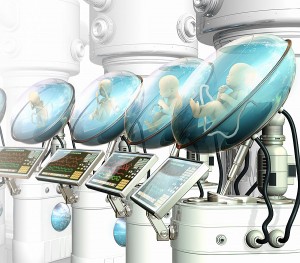Written by Ivey Ingalls-Rubin, Staff Writer

”One by one, the eggs were transferred from their test-tubes to the larger containers; deftly the peritoneal lining was slit, the morula dropped into place, the saline solution poured and already the bottle had passed on through an opening in the wall, slowly on into the Social Predestination Room.” Aldous Huxley, ”Brave New World”
Ectogenesis, a term coined by J.B.S.Haldine in 1924, is used to describe a pregnancy occurring in an artificial environment, from the point of fertilization to the eventual birth. During Haldine’s time, he predicted that this form of “pregnancy” would account for more than 70 percent of human births by 2074.
Though 2074 may seem as though it’s long in the future, his prediction may yet be on target.
Researchers in Tokyo have developed a unique technique called EUF, or extra-uterine fetal incubation, for which all intent and purposes has given birth to the artificial womb. These researchers have gone as far as taking goat fetuses, winding catheters through big blood vessels that lie in the umbilical cord and provided fetuses with oxygenated blood; meanwhile keeping them suspended in incubators that contain all artificial amniotic fluid that’s been heated to body temperature.
Yoshinori Kuwabara, chairman of the Department of Obstetrics and Gynecology at Junedo University in Tokyo, has been pursuing the artificial placentas for about a decade. Kuwabara along with his associates have managed to sustain the fetus in this artificial environment for as long as three weeks.
Although the doctoral team ran into issues with circulatory failure and other technical difficulties, Kuwabara and his colleagues cautiously predict that they should be able to extend the length of time and eventually, apply their EUFI to human beings.
Current legislation, however, halts research projects involving human embryos after 14 days. So it may take some time before ectogenisis research will be fully capable of gestating human embryos.
Ectogenisis does hold quite the potential to be an efficient and on occasion life-saving ordeal for both the woman and the child.
In fact, ectogenisis has already sparked a largely controversial debate—“Is human still applicable if embryos are not technically bred of a human womb? What will the tem mother equate to? What’s to come of the feminine mystique? Will it be lost by the use of an artificial process replacing the long mainstay of the female domain?”
These questions have all caused quite the rift involving scientists, feminists and the public in general.
Though both sides hold validity in their approaches, ectogenesis could ultimately improve the health of babies. Through this monitored process, doctors and parents alike would have the opportunity to carefully observe each and every heartbeat and movement of the fetus. Each nutrient administered to the fetus would be measured; each heartbeat analyzed. The doctors and parents would witness the entire development course, from the zygote all the way to the very moment the baby is ready to be birthed.
Though this process is completely new and a long way from being implemented into society as a norm, it could give way to a promising safe and efficient process with much practicality.
To learn more about the artificial womb please visit HERE.
 The Spectator The independent student newspaper of Valdosta State University
The Spectator The independent student newspaper of Valdosta State University






